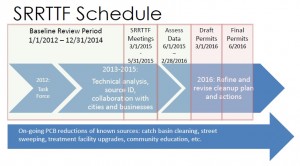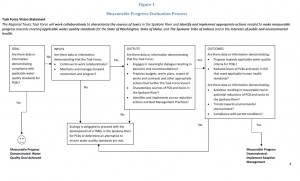Washington State Department of Ecology: Measurable Progress (for Washington Permits)
Figure 1: Measurable Progress Determination Process from Department of Ecology Measurable Progress Definition.

Figure 2: Measurable Progress Determination Schedule, Department of Ecology Presentation at February 25, 2015 Task Force Meeting.
Measurable Progress evaluates the status of three key indicators
Inputs: organizing activities
Outputs: activities and work products
Outcomes: Progress toward achievement of the applicable water quality criteria for PCBs in the Spokane River • Achievement of the applicable water quality standards • Achievement of health standards • Measured reductions of toxics to or in the Spokane River.
The following conditions, when accompanied by defensible data, will be considered a demonstration of measurable progress:
- Compliance with applicable water quality standards for PCBs
- Evidence that the Task Force is functioning in a collaborative manner and continuing to engage in activities that will lead to the reduction of PCBs in the river.
- Development and implementation of a comprehensive Spokane River toxics reduction plan.
- Actions that eliminate, remove, or isolate PCB from the river or watershed.
- Environmental trends showing a decrease of PCB in the river, sediments, or biota.
What if?
- The river meets water quality standards – Task done, celebrate
- Task Force is working well together and moving towards the goal? – Measurable Progress is evident.
- Task Force is working well together and environmental outcomes not evident? – Review with the Task Force and permittees, identify adaptive management measures.
- Task Force is not working, not meeting nor creating meaningful work products – Ecology is obligated to proceed with a TMDL or alternative.
Inputs
“Inputs focus on the activities needed for the SRRTTF to organize, function, and achieve results. Examples include signing the MOA, convening regular meetings, seeking financial assistance, and budgeting. Inputs are important because they lead to trust, collaboration and agreement on actions needed to achieve results. Measures include numbers of key decisions, meetings, and actions directed towards funding the Task Force activities. Inputs are important during the entire process but of higher priority during the first permit cycle.” (Department of Ecology Measurable Progress Definition, Attachment A)
Outputs:
“Outputs are the activities and work products of the SRRTTF. Examples include reports, plans, studies, contracts, workshops, and permits. Outputs are important because they fill in the gaps with respect to the data and processes needed to identify and implement source reductions. Measures include numbers of reports, plans, studies, contracts, workshops, and permits that contribute towards achieving source reductions. Outputs are important to the entire process but of higher priority during the first permit cycle.” (Department of Ecology Measurable Progress Definition, Attachment A)
Outcomes:
“Outcomes are the environmental results and measurable source reductions in the river as well as quantifiable source reduction actions. Outcomes indicate the effectiveness of actions that have been taken and quantify the amount of PCB known to have been removed from the Spokane River and Spokane River watershed. Outcomes are important throughout the entire process but of higher priority after the first permit cycle. Examples of output measures include trending levels of PCB in fish and the water column, achievement of the applicable water quality standards for PCBs, permit compliance status and environmental trends relating to PCBs.” (Department of Ecology Measurable Progress Definition, Attachment A)

